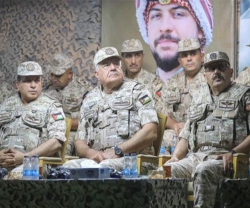Boeing, JHU Demo Expanded Control of UAV Swarm
08.08.2012 North America
Boeing and the Johns Hopkins University Applied Physics Laboratory (JHU/APL) have demonstrated that an operator on the ground, using only a laptop and a military radio, can command an Unmanned Aerial Vehicle (UAV) “swarm.”
Despite limited flight training, the operator was able to connect with autonomous UAVs, task them and obtain information without using a ground control station.
The team conducted flight tests in Oregon for several days in June, using two ScanEagle UAVs manufactured by Boeing subsidiary Insitu and swarm technology developed by JHU/APL. The technology allows UAVs to perform similarly to a swarm of insects, completing tasks more quickly and efficiently by communicating and acting together.
Boeing and JHU/APL conducted two tests last year in which dissimilar unmanned platforms across air, land and sea domains collaborated to autonomously conduct searches and communicate information.
“This swarm technology may one day enable warfighters in battle to request and receive time-critical intelligence, surveillance and reconnaissance information directly from airborne UAVs much sooner than they can from ground control stations today. Swarm network technology has the potential to offer more missions at less risk and lower operating costs,” said Gabriel Santander, Program Director of Advanced Autonomous Networks for Boeing Phantom Works.
The demonstrations are conducted under a collaborative agreement between Boeing and JHU/APL, a University Affiliated Research Center and a division of Johns Hopkins University that has been addressing critical national challenges through the innovative application of science and technology for nearly 70 years. It maintains a staff of about 5,000 on its Laurel, Maryland, campus.
Despite limited flight training, the operator was able to connect with autonomous UAVs, task them and obtain information without using a ground control station.
The team conducted flight tests in Oregon for several days in June, using two ScanEagle UAVs manufactured by Boeing subsidiary Insitu and swarm technology developed by JHU/APL. The technology allows UAVs to perform similarly to a swarm of insects, completing tasks more quickly and efficiently by communicating and acting together.
Boeing and JHU/APL conducted two tests last year in which dissimilar unmanned platforms across air, land and sea domains collaborated to autonomously conduct searches and communicate information.
“This swarm technology may one day enable warfighters in battle to request and receive time-critical intelligence, surveillance and reconnaissance information directly from airborne UAVs much sooner than they can from ground control stations today. Swarm network technology has the potential to offer more missions at less risk and lower operating costs,” said Gabriel Santander, Program Director of Advanced Autonomous Networks for Boeing Phantom Works.
The demonstrations are conducted under a collaborative agreement between Boeing and JHU/APL, a University Affiliated Research Center and a division of Johns Hopkins University that has been addressing critical national challenges through the innovative application of science and technology for nearly 70 years. It maintains a staff of about 5,000 on its Laurel, Maryland, campus.
Previous PostU.S. Marine Corps Uses Oshkosh TerraMax™ UGV
Latest news
Latest events
IDEF 2025 Turkey - International Defence Industry Fair
22 - 27 Jul 2025Istanbul Expo Center - TurkeyDSEI 2025
09 - 12 Sep 2025Excel, London - United KingdomIntersec Saudi Arabia
29 Sep - 01 Oct 2025Riyadh International Exhibition & Convention Centre - Saudi ArabiaDubai International Air Chiefs’ Conference (DIACC 2025)
16 Nov 2025Atlantis, The Palm Dubai - United Arab Emirates






















